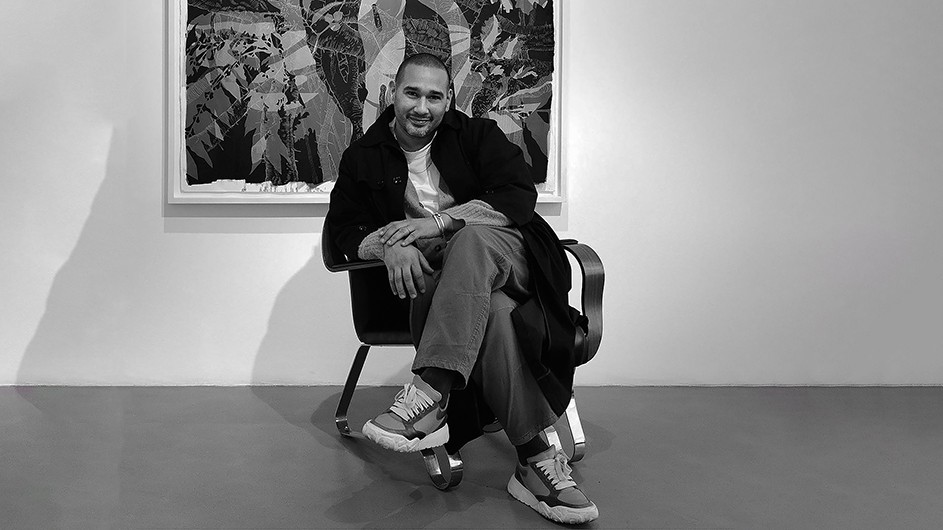An Artist Who Is Present Both in the Classroom and in Museums
School of the Arts Professor David Antonio Cruz has recently been teaching and exhibiting his work in multiple museum exhibitions.

It has been a busy time for David Antonio Cruz, an interdisciplinary artist whose work embraces painting, drawing, and performance. A professor in the Visual Arts and Sound Art Program at School of the Arts, Cruz had his artwork in four different exhibitions recently. When the Children Come Home was a solo exhibition, which just closed, devoted to Cruz at the Institute of Contemporary Art in Philadelphia. Two group shows that included work by Cruz also ended recently, one at the Tufts University Art Galleries in Medford, Massachusetts, and the other at the Zuckerman Museum at Kennesaw State University in Kennesaw, Georgia. The fourth show, another group one with work by Cruz, is Something Beautiful: Reframing La Colección, which is on view through March 10, 2024, at the Museo del Barrio in New York City.
Cruz’s art examines the intersectionality of queerness and race, centering Black, Brown, and queer bodies to explore personal and collective history and culture. By incorporating literature, language, and sculptural elements, his work engages portraiture as a place of permanence and as a form of resistance to normative conventions.
Cruz discusses his creative practice and exhibitions with Columbia News, along with what he’s currently teaching, and what it’s like to work at School of the Arts and in New York.
You had work in four museum exhibitions this fall. How did that happen?
I've been in conversation with curators for a while about some of these projects. A few shows were pushed back as a direct result of the pandemic. It's very common to have different projects moving simultaneously at various institutions.
Of the four, is there one that is the most meaningful to you, perhaps When the Children Come Home, since it's in your hometown of Philadelphia?

When the Children Come Home is a special project. Although it is not my first solo show, it's the first expansive survey of my work, exploring ideas of home and its intersections with geography, diaspora, LGBTQ+ culture, and autobiography. The project features recent work that references deeply and personally meaningful sites in Philadelphia. More than 30 large paintings, drawings, and objects, including an immersive, site-specific installation, are included in the exhibition.
Back in October, as part of the Philadelphia show, you and others did a live performance, incorporating original scores, costumes, and music. Is performance a large part of your creative practice?
Yes, I performed green,howiwantyougreen at the ICA Philadelphia and the Poetry Foundation in Chicago. green,howiwantyougreen is an experimental operatic performance piece based on Sonnets of Dark Love, the last 11 poems by the Spanish poet Federico García Lorca. They were banned for 50 years following his assassination in 1936. Featuring four voices, a reader, and a musician, the bilingual Spanish and English libretto fuses references to popular culture, queer slang, and Latino and Black gay culture to explore love and desire in dark places.
I wrote this piece eight years ago with music by my long-time collaborator, Daniel de Jesús. Performance and interventions have been a large part of my work for over 15 years. The paintings and performances exist in the same world: They engage and breathe the same air; they just have different sounds and interactions.
How do you manage your own work and teaching? Do the two overlap, or do you keep them separate?
I am very present and in the moment when I'm in my studio and in the classroom. I also like sharing my research, studio, and professional practice with my students. Being an artist can be very abstract to many people. It's essential that students learn what it is to have an art practice.
What was your path to a career that embraces academia and art production?
Years ago, artists invited me to teach a painting class. It was a rewarding way to support my practice, share my experience, and mentor a new generation of artists.
Any advice for students interested in following a similar trajectory?
Develop your artistic voice, work hard, and love what you do. Build a community of artists and surround yourself with like-minded individuals.
What are you teaching in the spring semester?
I am teaching Graduate Studio and Figure Painting this spring.
What is special about teaching at the School of the Arts and in New York?
We have an incredible faculty, all teaching in an interdisciplinary program where the lines between ideas, mediums, and studio practice are blurred. Students are mentored by scholars and leading figures in their craft and discipline. The school being in the city creates many opportunities for students to engage, participate, and become exposed to numerous artists, scholars, and institutions, unlike any other place in the country.